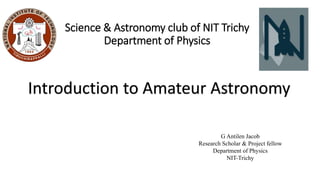
Science and astronomy (basic astronomy)
- 1. Science & Astronomy club of NIT Trichy Department of Physics Introduction to Amateur Astronomy G Antilen Jacob Research Scholar & Project fellow Department of Physics NIT-Trichy
- 2. Course contents I. Weekly lecture program • Introduction on celestial object ( 2 hours) • Formation and kinetics of solar system ( 2 hours) • life cycle of stars ( 2 hours) • Telescope optics and basic operation ( 2 hours) • Introduction to astronomical software's ( stellarium ) (1 hour) • space observatory( X-ray, UV, infrared) ( 2 hours) • Introduction to cosmology (2 hours) II. Telescope Live streaming (based on weather conditions) • Live web streaming of planets through 10” telescope ( 1 hour) III. Quiz competition • Quiz question link will be forwarded each week. ( 4 set) IV. Q&A discussion session • Special session for addressing questions from students.( 1 hour) V. Building a Galiloscope • 3d printed parts and lenses will be given to construct a galiloscope. VI Participants presentation • 10 min talk followed by 2 min discussion VII overall prize • Based on the regular attendance and performance in quiz and Q&A discussion
- 3. Earth as filter • Limitation due to atmosphere • earth is a window only for visible and radio waves • earth magnetic field protecting us form solar wind • ozone layer will not allow UV radiation • High pressure will keep the water in liquid state Armature astronomy Visible astronomy Radio astronomy
- 4. Telescopes in our NIT campus 10” Newtonian reflector telescope Horn antenna radio telescope (21 cm) Copper probe VNA Spectrum Analyzer Filter and LNA
- 5. How the universe look like from earth • we can see more than 2,000 stars as well as the Milky Way. • Constellations (88 constellations fill the entire sky)
- 6. How to look in to sky • Zenith: The point directly overhead • Horizon: All points 90° away from zenith • Meridian: Line passing through zenith and connecting N and S points on horizon
- 7. Why do stars rise and set? A circumpolar star never sets This star never rises Your Horizon Celestial Equator • Earth rotates west to east, so stars appear to circle from east to west • polar star will aligned with the axis of a rotating astronomical body • Earth's pole stars are Polaris (Alpha Ursae Minoris)
- 8. Length scale 1A.U. = 1.5 X 1011 m 1ly = 9.46 X 1015 m 1pc = 3.08 X 1016 m or 3.26 ly • Lightyear is a unit of distance • Moon is 1.2 Light second away from earth • parsec is the distance at which 1A.U. subtends an angle of 1 arc second • Diameter of the observable universe is 93 Gly
- 9. Measuring distances • Parallax method • Variable stars method • Color • The expanding universe 𝑡𝑎𝑛θ = 𝑂𝑝𝑝𝑜𝑠𝑖𝑡𝑒 𝑠𝑖𝑑𝑒 𝑎𝑑𝑗𝑒𝑐𝑒𝑛𝑡 𝑠𝑖𝑑𝑒 𝑑 = 1 𝐴. 𝑈. 𝑝
- 10. Mass scale • The solar mass (M☉) is a standard unit of mass in astronomy • M☉ = (1.98847±0.00007)×1030 kg • The solar mass is about 333000 times the mass of Earth (M⊕), or 1047 times the mass of Jupiter (MJ). Pollex= 1.91±0.09 M☉ Sirius = 2.063 ± 0.023 M☉ Betelgeuse = 11.6 M☉ Regel = 21±3 M☉ Antares = 14 M☉
- 11. Angular size (diameter) • We can measure both the size of an object in the sky and mark its position by using angles • There are 360 degrees in a circle 1/60th of a degree is one arc minute and 1/60th of an arcminute is one arc second • Angular size of moon is 0.5 degree same as sun • Orion nebula has angular size of 5 degree 1° = 1 360 𝑡𝑢𝑟𝑛𝑠 1′ = 1 60 𝑑𝑒𝑔𝑟𝑒𝑒 1" = 1 3600 𝑑𝑒𝑔𝑟𝑒𝑒 Problem 1) Calculate the diameter of the sun if the angular size of the sun is 0.5 degree? Problem 2) Calculate the distance between Jupiter and IO if the angular separation between them is 1.863 arc minute and the distance between earth and Jupiter Is 760 million kilometers?
- 12. Apparent magnitude • describe how bright an object appears in the sky from Earth • Magnitude scale dates back to Hipparchus (around 150 BC) who invented a scale to describe the brightness of the stars he could see • magnitude of 1 to the brightest stars in the sky Absolute magnitude Absolute magnitude is defined to be the apparent magnitude an object would have if it were located at a distance of 10 parsecs
- 13. Apparent and absolute magnitude • mv – Mv = – 5 + 5 log10(d) • Brightness, color, luminosity and magnitude, temperature. • α-Centauri has 0.01 and β-Centauri has 0.61 • α 4.2ly, β 390ly. Absolute magnitude of α and β are 4.38 and -4.53 respectively. • Color Temperature 3000K to 50,000 K based on spectral class
- 14. Tidal locking and synchronous rotation • 4 billion years ago 1 earth day is 6 hours • internal frictional due to gravity consumes the energy of moon rotational motion • earth stretches different direction every 24 hours now • which reduces the rotational velocity of earth
- 15. What's visible today in sky? • Jupiter • Saturn • Deneb, Vega, Altair • Antares Planets 20 degree south-east 45 degree North-east 26 degree south Antares Deneb
- 16. Thank you
